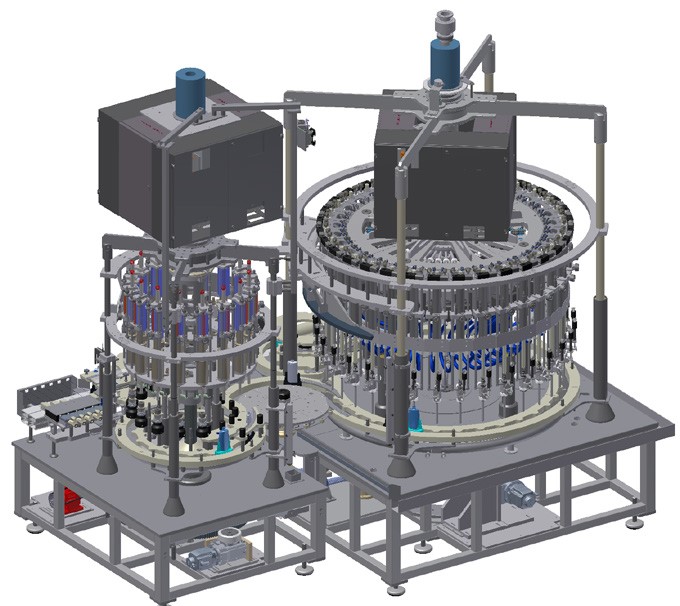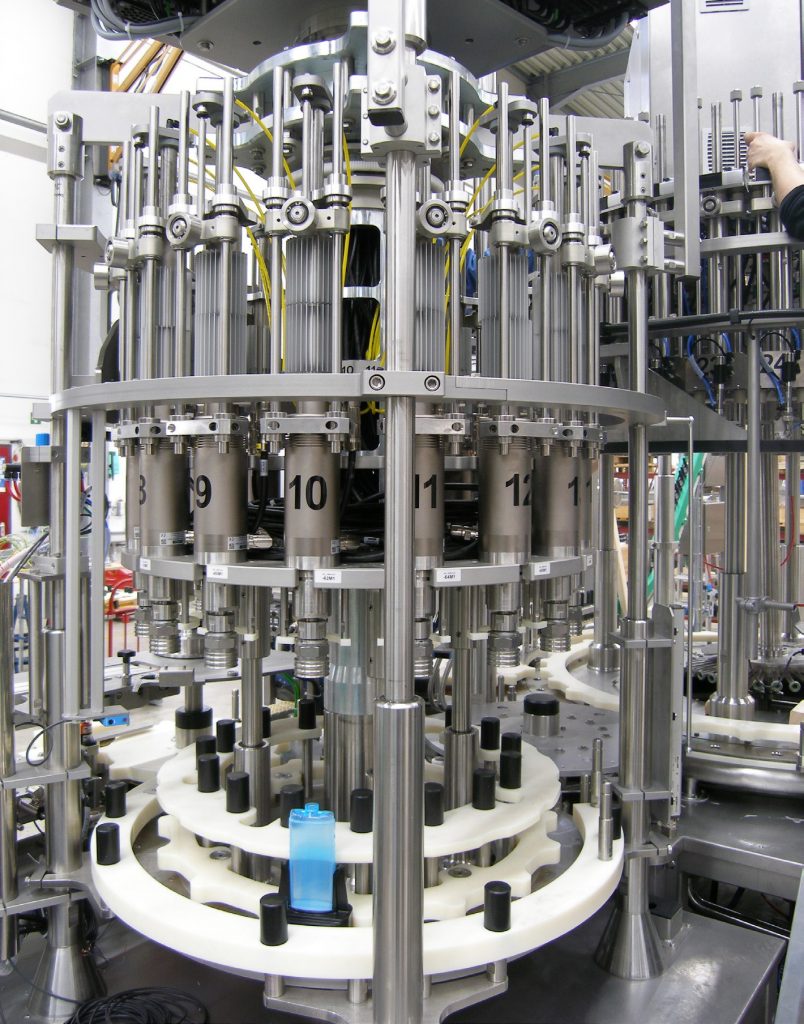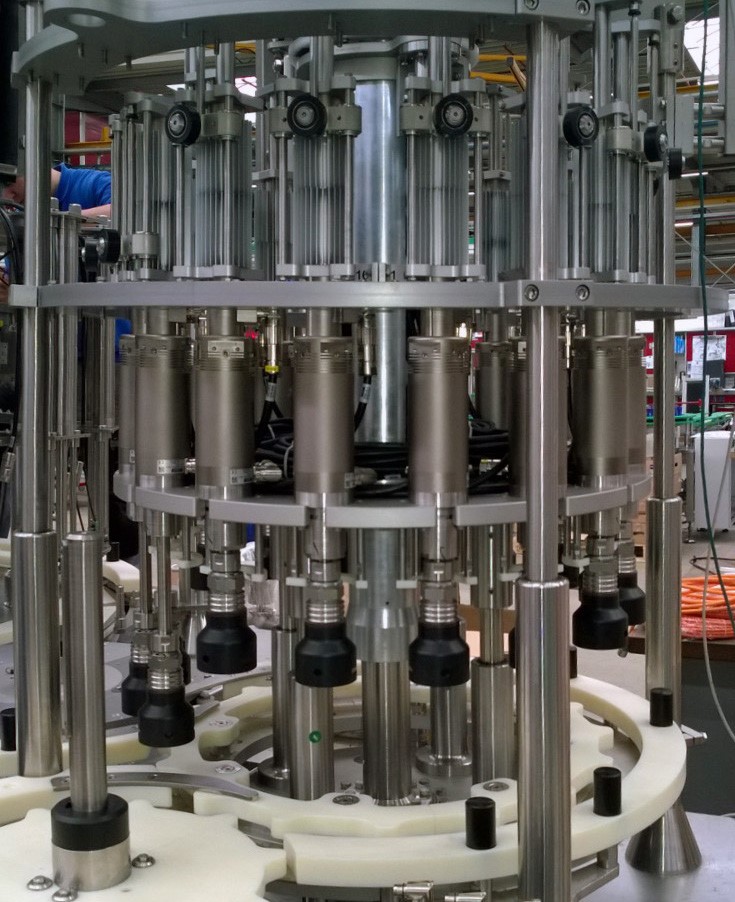Closure processes can be designed much more flexibly with linear rotary motors than with conventional cam disc technology. That is why Tölke, a packaging machinery specialist, has outfitted its new high-performance filling and closing line with linear rotary motors from LinMot. The operator of the system profits from shorter setup times, lower downtime, and a wider range of applications for the machine.
You are currently viewing a placeholder content from Default. To access the actual content, click the button below. Please note that doing so will share data with third-party providers.
«Mechanical cam discs have proven their worth in linear-motion processes for decades and will continue to be used in many lower- and medium-performance filling and closing machines in the future,» says Franz-Josef Patzelt, one of the managing directors of Franz Tölke GmbH. «With their electronic pendants, however, the closure process is much easier to adapt to individual product requirements, and product changeover can be done much more quickly, which more and more users are demanding.» The company had already done a lot in the past to add flexibility to their filling and closing machines that use conventional cam-stroke technology. By using transport cups with identical outer shape and individualized inner contours, often only the cups had to be swapped out for a product changeover. If it was necessary to swap out all of the part-specific components of a machine, then Tölke made sure that this could be done quickly by hand, with no tools required.
Flexible carousel with 16 linear rotary motors
If the closing process itself needs to be modified for a product changeover, however, it is usually necessary to change out the mechanical cams involved in the linear motion of the screwing process. Because this is a time-consuming and costly process, Tölke has now built a carousel machine with 16 closing stations for an application with frequent product changeovers. The entire screwing process is handled by one model PR01-84 linear rotary motor at each station. This electric motor, part of the PR01 series from LinMot, was specially developed for the closing and screwing process. It combines both a linear motor and a rotary direct drive in a compact housing, each of which is controlled separately. This means that any combination of linear and rotary motions can be implemented. «For the rotary part of the screwing process, we have been using a rotary servomotor instead of a pneumatic motor for a long time wherever the screwing application requires a defined turn angle and a defined torque, and when we want to perform a product changeover at the push of a button.» explains Franz-Josef Patzelt.

Flexible filling and closing machine from Tölke for output capacity of up to 300 bottles/min and a filling volumes of up to 250 ml. (Rendering: Tölke))
Closer with electronic linear axis
What is new, however, is the use of an electronic linear axis in the closer. «The cap needs to be picked up, placed on the bottle, and then guided so as to provide optimal support for the rotary motion,» says Markus Kröger, the Tölke project manager responsible for this job. «If this linear motion were controlled by a cam disc, then the heights at which the cap is picked up and placed down would be fixed, and the entire motion sequence would be defined.» If modifications to the motion sequence were required for a product changeover, then the mechanical solution would require different closure heads or even different cam discs to be installed, or the machine builder would have to integrate adjustable cam discs. In some cases, a spring would also need to be installed to compensate for the weight of the head. «With a direct drive and an electronic stroke curve, none of this is needed anymore,» explains Markus Kröger. With the right parameter sets for the programmed motion sequence, or by invoking a predefined recipe, the motion of the linear motor can be designed as needed and optimally adapted to the individual requirements of the application.»

By using the linear rotary motor from LinMot, Tölke was able to decouple the closing process from the motion of the turntable. This allows a closing station to be swapped out much faster in case of damage, thus minimizing downtime. (Photo: Rossmann)
Freely programmable motion sequences
This also allows different types of types of closures such as screw-on and caps can be processed on one machine. machine. Even different bouncing forces or thread pitches, such as containers with and without without a safety closure, can be can be handled with a linear drive without conversions. Furthermore, with a lifting motor like the PR01 with its two two independently operating axes independently of the position of the position of the rotary table during the the rotary movement can be started during the can be started. The machine builder gains additional freedom in the design of the the design of the machine, which which allows him, for example, to shorten the cycle time.
Simple changeover of the screwing station
The mechanical decoupling of the closing process from the carousel or turntable was used by the engineers at Tölke to promote the modularization of the machine. If a screwing station is damaged, it can now be replaced in a short time, so the machine can get back to work much faster after a crash. In addition, because they are decoupled, the closing process can be completed for all containers in the line prior to a planned machine stop.
In order to further reduce the downtime and monitor the screwing process, the information produced by the linear rotary drive for each individual screwing process (torque, speed, angle, vertical position, speed, and force) can be analyzed.
«We can use the data provided by the drive to determine the number of revolutions actually performed, so that a separate check of the height of the closed container in order to monitor the screwing process can also be eliminated, » adds Franz-Josef Patzelt, citing a practical example. The drive data for snap-on caps can also be usefully applied for monitoring purposes. An error message can be generated if a prescribed value for the snap-on force is exceeded due to an interfering injection point.

The monoblock line has space for 16 closing stations. Linear rotary motors allow rapid product changeover and broaden the range of application of the filling and closing machine. (Photo: Tölke)
Ready for Industry 4.0
The use of linear motors has even more advantages that optimally support the modern concept of «Industry 4.0». Information provided by the servo controller, such as the current motor temperature or the acceleration curve, can be used to monitor the filling process and detect problems with the mechanical systems (condition monitoring) or collisions at an early stage. The machines that Tölke has equipped with this new technology include a blocked filling and closing machine with 36 filling stations and 16 closing stations, where the strokes of the filling needles are each perfumed by linear motors from LinMot (series PS01-48 stators with series PL01-27 sliders).
Linear rotary motor from LinMot: compact and robust
Due to these many advantages, Tölke had already developed a solution prior to the use of the PR01 linear rotary motor, wherein the linear motion was generated by a servomotor in conjunction with a ballscrew spindle. The ballscrew, however, had to be protected against dust, which requires additional design effort that is not necessary for the fully assembled linear rotary motor. «The linear rotary motor from LinMot is much simpler to use, as an integrated unit, and takes up less space, » says Markus Kröger. «The PR01 is thus the ideal solution for lines like our high-performance closing machines, where the rotary screwing process must be as flexible and efficient as possible.»
More about our linear rotary motors

The electric motors, part of the PR01 series from LinMot, were specially developed for the closing and screwing process. They combine both a linear motor and a rotary direct drive in a compact housing. (Photo: LinMot)
You are currently viewing a placeholder content from Yumpu. To access the actual content, click the button below. Please note that doing so will share data with third-party providers.
More Information